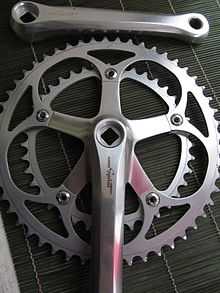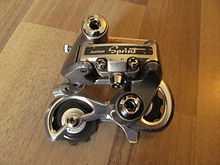SunTour
SunTour or SR Suntour is a manufacturer of bicycle components. It was Japanese-owned and managed, based in Osaka, until the mid-1990s when its name was sold to a Taiwan conglomerate. Its products ranged from suspension forks to derailleurs. SunTour reached a zenith of sales and commercial success from the late 1970s to the mid-1980s.
History





Begun in 1912 as Maeda Iron Works Company manufacturing freewheels and sprockets, the company concentrated on producing bicycle gearing components.
In the 1950s, the company began producing its version of pull-chain, rod-guided, touring derailleurs, similar to those of French derailleur companies such as Huret and Simplex.
In 1964, Suntour invented the slant-parallelogram rear derailleur. The parallelogram rear derailleur had gained prominence after Campagnolo's introduction of the "Gran Sport" in 1949,[1] and the slant-parallelogram was an improvement of it that allowed the derailleur to maintain a more constant distance from the sprockets, resulting in easier shifting.[2] The SunTour derailleur cost less than Campagnolo, Huret, Shimano, or Simplex and it performed especially well shifting under load, as when changing to a lower gear while pedaling up a steep incline. A contemporary Consumer Reports test reported that "SunTour was far and away the easiest to shift and the most certain of arriving at the right sprocket."
Suntour's slant-parallelogram, spring-loaded top pivot rear derailleur provided the best shifting on the market. When Suntour's rear derailleur patent expired, the design was promptly adopted by Shimano.
In 1969, SunTour was the first Japanese gear and shifter manufacturer to introduce indexed shifting on bicycles (indexed shifting appeared at least as early as the Funiculo derailleur fitted to 1935 Shultz bicycles[1]). Although their system, called Five-Speed Click, worked well, it proved an idea ahead of its time and did not catch on with the riding public. Another design innovation was the first practical Japanese freehub - the Unit-Hub - which combined freewheel and hub in one component (unit hubs were available at least as early as the 1938 Bayliss-Wiley, probably earlier[3]). The freehub greatly increased the strength of the rear wheel, but the idea was not pursued.[2]
In the early 1970s, demand created by the bike boom in the United States exceeded the capacity of European manufacturers. SunTour and Shimano filled the vacuum. SunTour focused on refining existing systems and designs for mid-level and high-end products.[4] Like Shimano, SunTour initially did not sell complete group-sets, so it teamed with other parts makers, such as Sugino for cranksets and Dia-Compe for brakes, so it could sell a complete line of SunTour branded components. Under these types of production agreements, companies did not have design control; if a cooperating component manufacturer decided not to upgrade or redesign its products, SunTour could do little about it. Shimano decided to greatly expand its research and development staff to 200 employees, enabling the company to end its component marketing agreements in order to produce hubs, pedals, brakes, and other components on its own in competition with its former partners.[2] In comparison, SunTour chose to continue with its existing research and development staff of some 20 persons, and remained primarily a bicycle gear and shifter manufacturer.[2]
Unlike other bicycle component manufacturers, Suntour did not charge what the market would bear, but instead charged a price that covered costs of production plus a small profit markup.[2] As a result, a Suntour derailleur costing $10 competed against similar level products from Campagnolo ($40) and Shimano ($20).[2] As Suntour derailleurs and shifters could be specified on many more low- and mid-priced bicycles, the company gained a reputation with the general public as a producer of only low-end equipment.[1] This reputation would eventually hurt sales when Suntour introduced a complete high-end component group, Superbe Pro.
Despite emerging problems, Suntour continued to achieve a number of innovations, particularly in components for mountain bikes. In partnership with Sugino, it introduced the 110/74mm BCD five-bolt triple crankset for mountain bikes, which soon became an industry standard. Next was the introduction of the Micro Drive 94/56mm BCD five-bolt compact mountain bike crankset, which saved weight, increased ground clearance, and permitted lower gearing for hill-climbing. New, short-cage rear derailleurs were provided to go with the Micro Drive cassette-type cogsets. The new system was very popular, and Shimano adopted the compact drive concept two years later. SunTour's new thumb and trigger shifters made shifting more convenient when riding off-pavement.
The company's decision to limit funding and staff for research and development caused running issues with new products. The first sign of trouble came with returns on SunTour's SR MounTech rear derailleur, caused by failures of the innovative spring-loaded jockey wheel that was fitted with a seal that proved inadequate to keep out dirt and mud.[2] In road bicycle components, the company fared no better. SunTour had introduced the SuperbeTech derailleur in 1983 with a streamlined, enclosed parallelogram. However, the design was too fragile, with internal pivots and the return spring failing frequently. It took special tools to repair and reassemble a SuperbeTech derailleur, resulting in many unhappy customers.[2] SunTour no longer had the resources to debug prototype designs before introducing them to the market, which cost the company in returns, repairs, and damaged reputation.
Another blow came when the yen was revalued in 1985. SunTour could no longer compete on costs with a slew of manufacturers producing in Taiwan and other lower labor-cost countries. Existing orders had been written in foreign currencies, rather than yen, so SunTour suffered a major loss. It had to borrow additional cash to finance a transfer of manufacturing facilities to Taiwan, as well as begin development of new mountain bike components.[2]
In 1987, SunTour introduced its new attempt at an indexed shifting system, AccuShift. AccuShift came late to the market to compete with Shimano's new SIS system introduced two years before, which cost SunTour dearly. With two years of lead time, Shimano could afford to require that bicycle manufacturers equip their bikes with complete SIS shifting systems, minimizing problems with product compatibility.[2] SunTour, on the other hand, desperately needed orders, so the company could not insist on complete SunTour component groups that had been tested to ensure compatibility with AccuShift.[2] As a consequence, major bicycle manufacturers such as Schwinn and Raleigh installed Accu-Shift on low-end bikes using inventories of older freewheels, hubs, cables, cable housings, and chains from other manufacturers. The practice resulted in a mismatched 'system' that did not provide the critical tolerances needed for reliable indexed shifting.[2]
In late 1989, Mori Industries Inc., a Japanese steel fabrication company, bought Sakae Ringyo Ltd., which made handlebars, cranksets, pedals, and seatposts. In mid-1990, Mori bought Maeda SunTour.
By 1993, SunTour's share of the market had dropped to five per cent of the U.S. market. At the end of 1994, Mori decided to shut down their bicycle component business. In March 1995 Daisuke Kobayashi and Hideo Hashizume, the former owners of SR Sakae Ringyo, arranged a management buyout. The new management took over in July, 1995, purchasing the SunTour name and the SR factory in Taiwan. Mori Industries left the bicycle component business, selling off SunTour's Japanese facilities piecemeal.
SR SunTour USA closed its U.S. offices in early 1995. The SunTour name lived on as SR Suntour, but the SunTour component designs did not survive. The tooling that produced the once-prized Suntour derailleurs, shifters, and associated bicycle components was sold for scrap.
Timeline 1987-2001
1987
- SR SUNTOUR was established by Sakae Ringyo Company with a capital investment of 45,000,000 NT$ in Tokyo, Japan.
1988
- Established a factory and office of 11,000 m2 (118,403 sq ft) at 7 Hsing Yeh Road, Fu Hsing Industrial Zone, ChangHua, Taiwan, and began manufacturing aluminium bicycle components.
- Received Taiwan government economic affairs department award for recognition of promotion of alloy melt-forging technology, upgrading Taiwan bicycle production techniques and encouraging investment in Taiwan.
- An extension of 500 m2 (5,382 sq ft) was completed, and production began of barrel finished aluminium products.
1991
- European office set up in Belgium
1992
- Started manufacturing front and rear dérailleurs in collaboration with Maeda Kogyo Co, of Osaka Japan.
1994
- 2,300 m2 (24,757 sq ft) were added to the second floor of the main factory.
1995
- New management takes over under SR Suntour
- SunTour tooling for existing components scrapped
- Commenced production of new dérailleurs and cog sets.
- Commenced production of front suspension forks for mountain bikes.
1996
- Commenced production of suspension forks for trekking bikes.
1997
- Awarded ISO 9001 certificate.
- Installed an automated like-motion press machine (500 ton) to produce cold pressed sprockets and cogs.
- Started producing mountain bike magnesium forks.
1998
- Ten-year anniversary celebrated during the Taipei International Bicycle Show.
- Installation of 500-ton magnesium alloy melt-forging machine to produce magnesium MTB suspension forks, and began research and development of similar products.
1999
- Government financial department stock management committee approved public issue of company stocks.
2000
- Investment and establishment of Japan branch office, to technical patents for products.
- Awarded ISO 14001 certificate.
2001
- New factory at ShenZhen, China begins production.
- Contract with Fujitsu, Japan to employ ERP company management computer system for future business expansion.
- USA office set up in Washington.
- Company profit capital investment reaches 457,380,000 NT$.[5]
2013
- 25th Anniversary of SR Suntour
References
- ↑ 1.0 1.1 1.2 Berto, Frank; Ron Shepherd et al. (2005). The dancing chain : history and development of the derailleur bicycle. San Francisco, CA, USA: Van der Plas Publications/Cycle Publications. ISBN 1-892495-41-4.
- ↑ 2.0 2.1 2.2 2.3 2.4 2.5 2.6 2.7 2.8 2.9 2.10 2.11 Berto, Frank. "Sunset for SunTour". Retrieved 2007-03-17.
- ↑ "Bayliss-Wiley Unit Freewheel Hub". Retrieved 2012-10-02.
- ↑ "Sun Tour revolutionized bicycle technology in the 1970s.". http://www.sheldonbrown.com/suntour.html Sheldon Brown. 2008-05-16. Retrieved 2008-10-14.
- ↑ "Official SR Suntour Website".
External links
| Wikimedia Commons has media related to Suntour. |